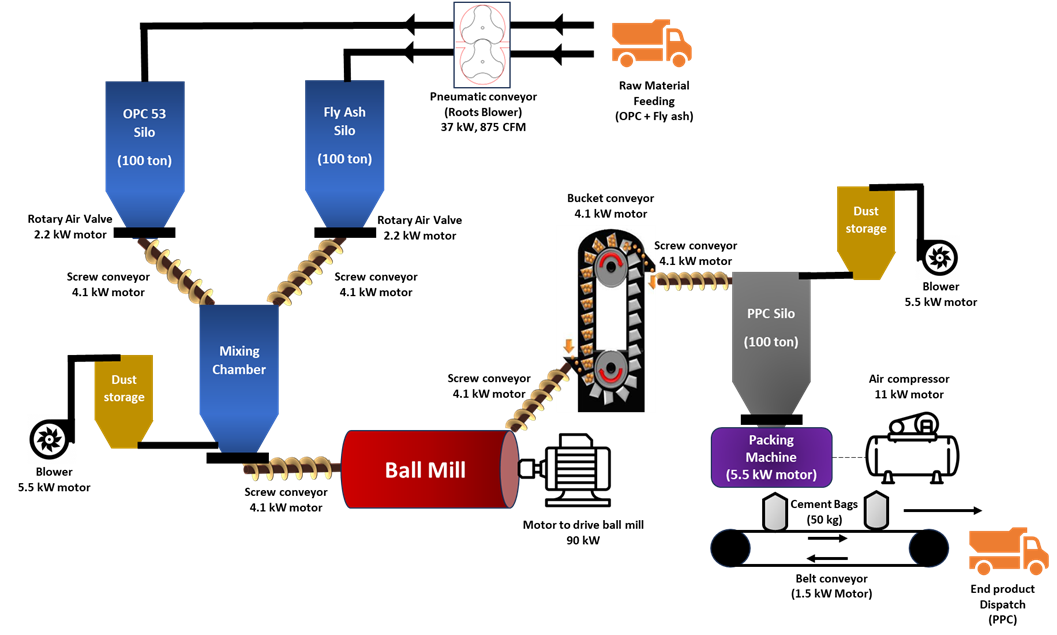CAG recently conducted a walk-through energy audit in Lakshanaa Pulverising Industries, a cement blending factory in Salem to decode the energy-saving avenues hidden within the cement blending process. This blog explores their process operation, major energy consuming equipment, and identifies energy saving opportunities within the cement blending industry.
Understanding the Process Operation:
Lakshanaa Pulverising Industries produces high-quality Portland Pozzolana Cement (PPC) Grade 33 by blending procured Ordinary Portland Cement (OPC) Grade 53 with fly ash. Their production capacity sits at 250 tons per day, translating to 3,000 tons monthly. Here's a breakdown of their process:
- Raw Material Delivery and Storage: OPC 53 cement and fly ash, delivered by trucks, are stored in separate silos, each with a 100-ton capacity. A pneumatic conveying mechanism powered by a 37 kW roots blower is used to transfer the materials to their respective silos.
- Mixing: The raw materials from silos are then sent to the mixing chamber with the help of screw conveyors that are powered by 4.1 kW motors. A rotary air lock valve operated by 2.2 kW motor discharges the material from the Silos to the Screw Conveyor.
- Ball Milling: The heart of the operation, a ball mill, blends the OPC and fly ash. A 90 kW motor powers the mixing chamber through a pulley and belt drive mechanism.
- Product Transfer: The final blended PPC 33 grade cement is then transferred to a product silo through a screw conveyor and bucket elevator.
- Packing and dispatch: The final product is packed into 50 kg bags using a semi-automatic packing machine. Belt conveyors powered by 1.5 kW motors facilitate product movement and then these bags are loaded into the dispatch vehicles.
- Dust Collection: Two bag filters capture dust generated during the process, with two 5.5 kW blowers (filter fan / baghouse fan) ensuring efficient operation.

Figure 1: Process flowchart in the cement blending factory | CAG
Energy and Cost Aspects:
- Energy Source: The energy used in the plant is only Electricity.
- Contract Demand: 112 kW [LT Service Connection]
- Tariff Structure: III B [Energy Charges: ₹7.65 / kWh; Demand charges: ₹ 153/ kW/month]
- Energy Consumption: Average 10,000 kWh / month
- Annual Electricity Cost: ₹15 Lakhs
Major Energy Consuming Equipment:
- Motors: The major energy consuming equipment in the unit is motors of various power ratings. There are about 12 motors with capacity ranging from 1.5 kW to 90 kW used to operate the ball mill, various conveyors, packing machines, etc.
- Blowers: They employ three blowers for pneumatic conveying mechanism (1 x 37 kW) and for dust collection (2 x 5.5 kW)
- Compressors: A compressed air system powered by 11 kW and 5.5 kW compressors supports the pulse jet valve operation and packing process.
Identifying Opportunities for Energy Savings:
The walk through audit revealed several promising areas where the industry can potentially save energy:
- Motor Optimization: Many plant motors are either old (some purchased second-hand), or rewound, potentially impacting their efficiency. A comprehensive performance assessment can identify underperforming motors and optimize energy usage.
- Drive Mechanism Efficiency: The current flat belt and pulley system driving the ball mill might be causing energy loss. Upgrading to a properly designed and executed drive mechanism could significantly reduce this loss. Studies suggest potential savings of 5-10% by optimizing belt size, tension, material selection, and pulley alignment.
- Air Compressor Evaluation: Analyzing the performance of the air compressors is crucial to ensure optimal operation and identify potential efficiency improvements.
- Load Management: Studying the plant's load profile can pinpoint peak demand periods. Implementing load shifting or shedding strategies during these times can lead to substantial cost reductions.
The Benefits of Energy Savings:
The preliminary audit suggests a potential energy saving of at least 5%, translating to roughly ₹1 lakh per year. However, a more detailed energy audit could uncover even greater opportunities for energy and cost reduction. By further embracing the energy-saving recommendations obtained from the detailed energy audit, Lakshanaa Pulverising Industries can not only reduce operational costs but also contribute to a more sustainable future. By minimizing their energy consumption, they lessen their environmental impact and promote responsible resource utilization.
Add new comment